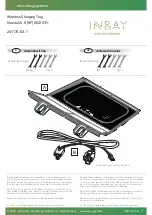
How to Charge the Battery Pack
Align the battery pack with the bay and slide the
battery pack into the charger as far as possible. The
red light will come on, either flashing (battery pack
is too hot or cold) or continuous (pack is charging).
• A fully discharged battery pack with an internal
temperature in the normal range will charge in 30
to 75 minutes, depending on the battery pack and
charger. Heavily cycled batteries may take longer
to charge completely.
• After charging is complete, the continuous green
light will come on.
• The charger will keep the battery pack fully charged
if it is left on the charger.
• If the light indicator flashes red and green, check that
the battery pack is fully seated into the bay. Remove
the battery pack and reinsert. If the light continues
to flash red and green, remove pack and unplug
charger for at least 2 minutes. After 2 minutes,
plug charger back in and insert pack. If the problem
persists, contact a MILWAUKEE service facility.
•
If the light indicator does not come on, check that
the battery pack is fully seated into the bay. Remove
the battery pack and reinsert. If the light indicator still
does not come on, remove pack and unplug charger
for at least 2 minutes. After 2 minutes, plug charger
back in and insert pack. If the light indicator still does
not come on, contact a MILWAUKEE service facility
Charging a Hot or Cold Battery Pack
The Red Flashing Indicator light on the charger in
-
dicates that the battery pack temperature is outside
the charging range. Once the battery pack is within
the acceptable range, normal charging will take place
and the red light will be continuous. Hot or cold bat-
teries may take longer to charge.
Li-Ion Charging Status
Battery Temp
Red Indicator
Light
Charging Status
140°F or more
32°F to 140°F
32°F or less
Flashing
Continuous
Flashing
Not charging
Normal charging
Not charging
Powering the Charger with an Inverter
or Generator
The charger will operate with most generators and
inverters rated at 100 Watts or higher.
Maintenance and Storage
Store your charger in a cool, dry place.
As a general practice, it is best to unplug battery
chargers and remove batteries when not in use.
No battery pack damage will occur, however, if the
charger and battery pack are left plugged in.
WARNING
To reduce the risk of injury, always
unplug the charger and remove the
battery from the charger before performing any
maintenance. Never disassemble the battery or
charger. Contact a MILWAUKEE service facility
for ALL repairs.
To reduce the risk of injury and damage, never
immerse your battery or charger in liquid or allow
a liquid to flow inside them.
of your battery pack according to federal, state and
local regulations. Contact a recycling agency in your
area for recycling locations.
Even discharged battery packs contain some energy.
Before disposing, use electrical tape to cover the
terminals to prevent the battery pack from shorting,
which could cause a fire or explosion.
RBRC Battery Recycling Seals
The RBRC™ Battery Recycling Seals (see "Sym
-
bology") on your tool battery packs indicate that
MILWAUKEE has arranged for the recycling of
that battery pack with the Rechargeable Battery
Recycling Corporation (RBRC). At the end of your
battery pack's useful life, return the battery pack to
a MILWAUKEE Branch Office/Service Center or
the
participating retailer nearest you.
MILWAUKEE
12V LI-ION
CHARGERS
WARNING
Charge only MILWAUKEE 12V
Li-Ion batteries in the MILWAUKEE
12V Li-Ion charger. Other types of batteries may
cause personal injury and damage.
To reduce the risk of electric shock, do not allow
water to flow into AC/DC plug.
AC/DC Charger (Cat. No. 2510-20)
To reduce the risk of damage to the charger, do not
attempt to plug into both AC and DC outlets at the
same time.
To use the AC/DC plug in a DC outlet, rotate the DC
adapter out (A) and insert into a DC outlet. The AC
plug blades should be folded in.
To use the AC/DC plug in an AC outlet, rotate the AC
plug blades out (B) and insert into an AC outlet. The
DC adapter should be folded in.
A
B
When to Charge the Battery Pack
with these MILWAUKEE Chargers
Remove the battery pack from the tool for charging
when convenient for you and your job. MILWAUKEE
batteries do not develop a "memory" when charged
after only a partial discharge. It is not necessary to run
down the battery pack before placing it on the charger.
• Use the Fuel Gauge (on the tool) to determine when
to charge your MILWAUKEE Li-Ion battery pack.
• You can "Top-Off" your battery pack's charge before
starting a big job or long day of use.
• The only time it is necessary to charge the
MILWAUKEE
Li-Ion battery pack is when the battery
pack has reached the end of its charge. To signal
the end of charge, power to the tool will drop quickly,
allowing you just enough power to finish making a
cut, drilling a hole, or driving a fastener. Charge the
battery pack as needed.
Rely only on high-grade power tools on our virtual shelves.
























